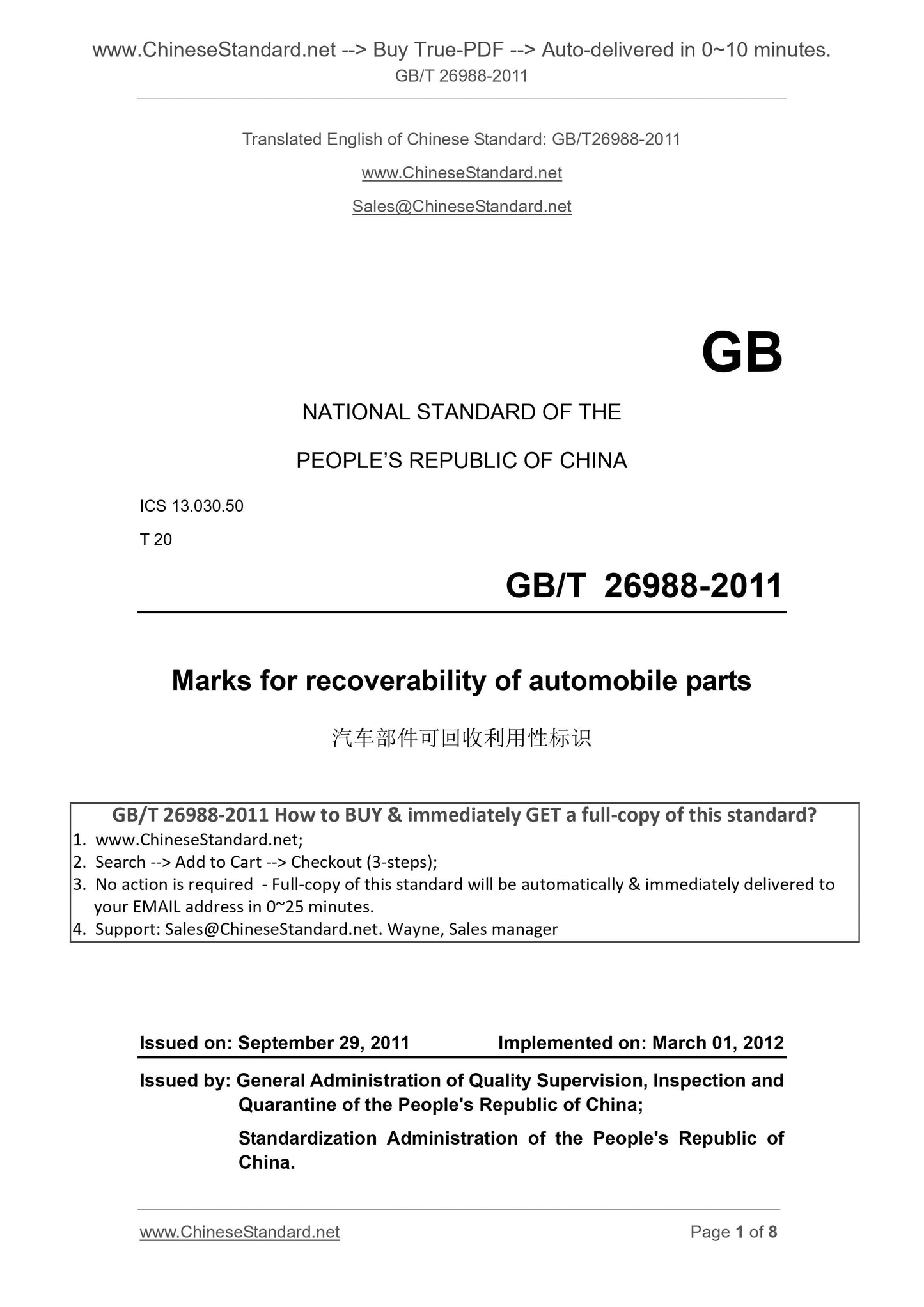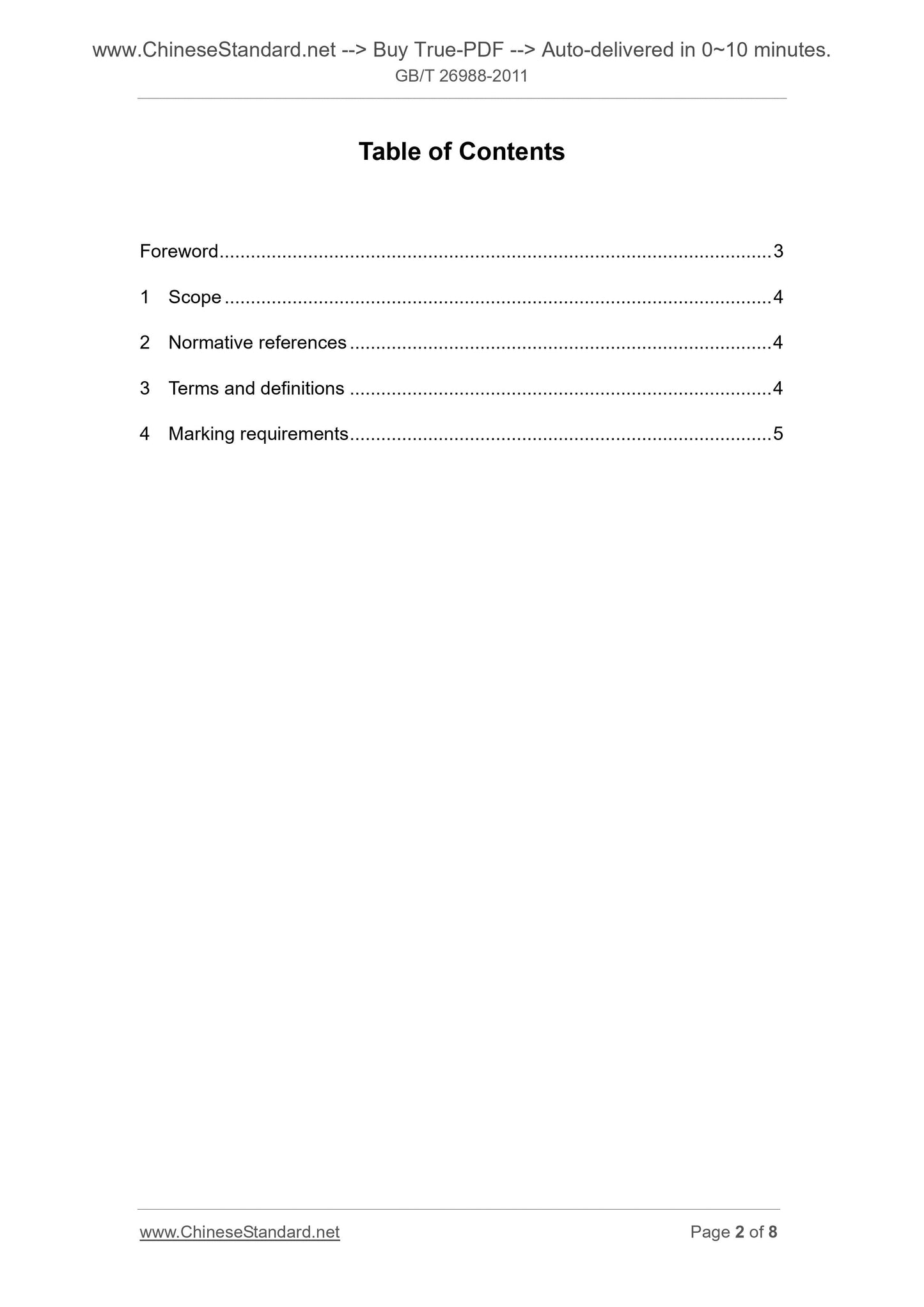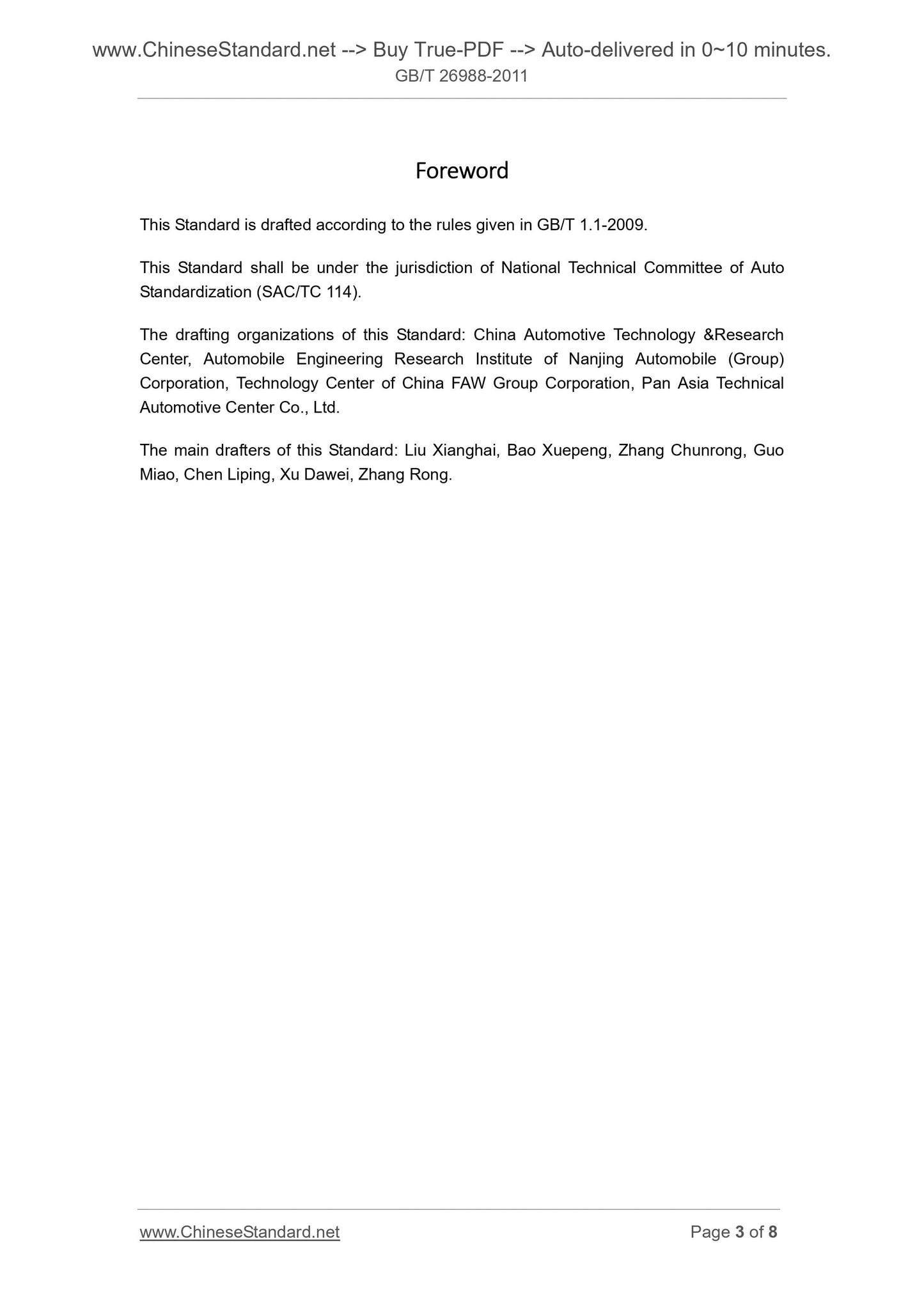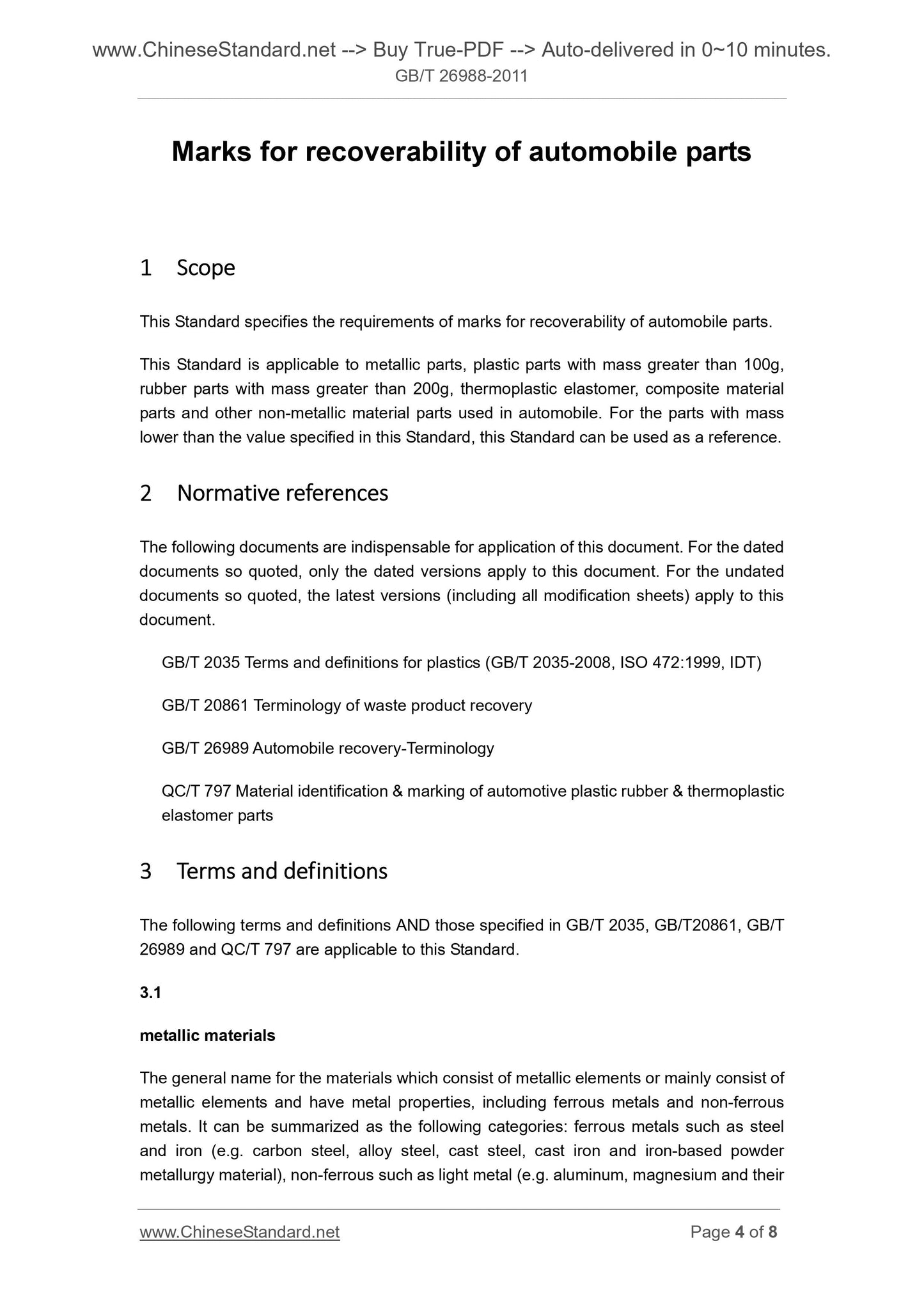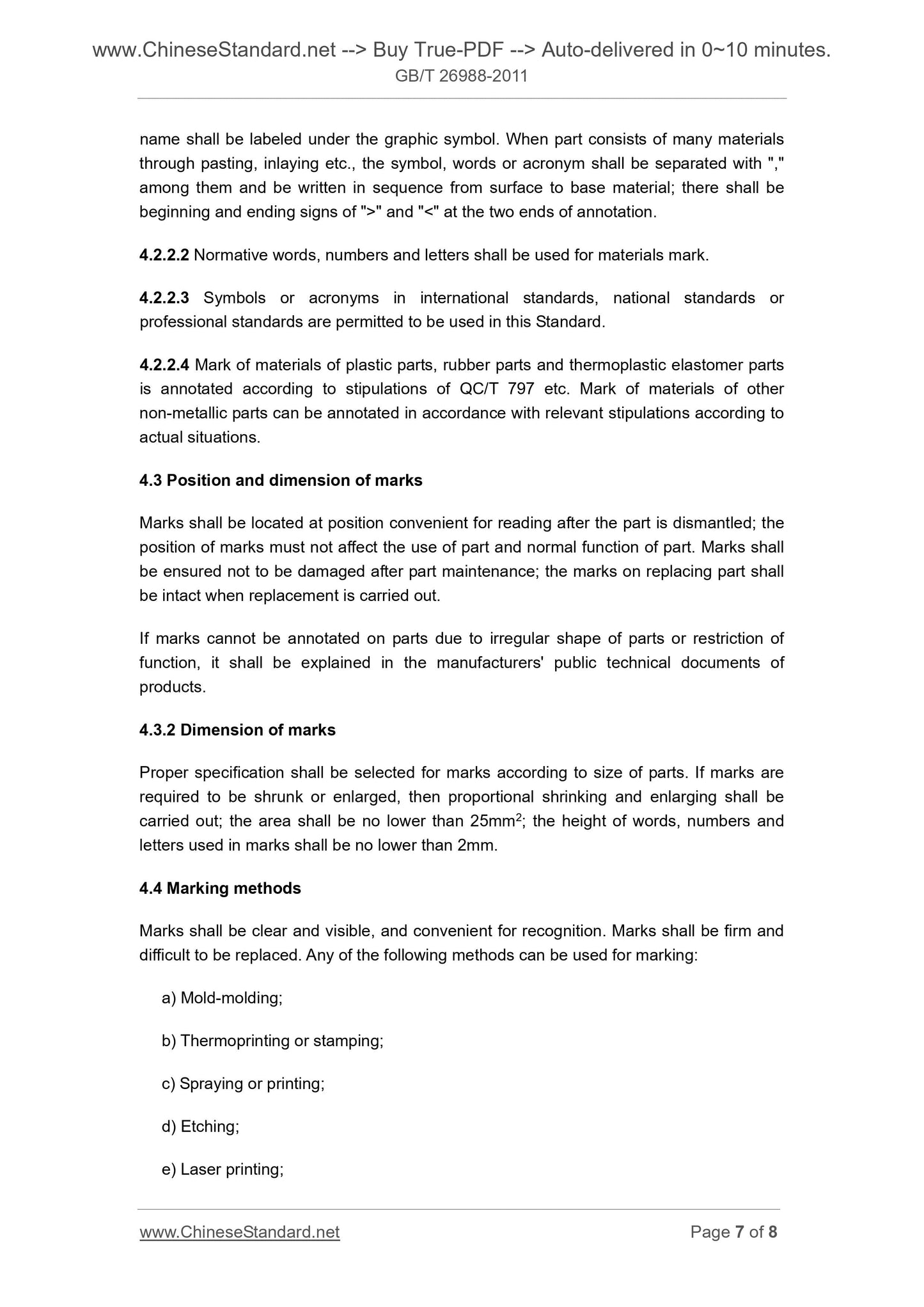1
/
of
5
PayPal, credit cards. Download editable-PDF and invoice in 1 second!
GB/T 26988-2011 English PDF (GBT26988-2011)
GB/T 26988-2011 English PDF (GBT26988-2011)
Regular price
$85.00 USD
Regular price
Sale price
$85.00 USD
Unit price
/
per
Shipping calculated at checkout.
Couldn't load pickup availability
Delivery: 3 seconds. Download true-PDF + Invoice.
Get QUOTATION in 1-minute: Click GB/T 26988-2011
Historical versions: GB/T 26988-2011
Preview True-PDF (Reload/Scroll if blank)
GB/T 26988-2011: Marks for recoverability of automobile parts
GB/T 26988-2011
GB
NATIONAL STANDARD OF THE
PEOPLE’S REPUBLIC OF CHINA
ICS 13.030.50
T 20
Marks for recoverability of automobile parts
ISSUED ON. SEPTEMBER 29, 2011
IMPLEMENTED ON. MARCH 01, 2012
Issued by. General Administration of Quality Supervision, Inspection and
Quarantine of the People's Republic of China;
Standardization Administration of the People's Republic of
China.
Table of Contents
Foreword ... 3
1 Scope ... 4
2 Normative references ... 4
3 Terms and definitions ... 4
4 Marking requirements ... 5
Foreword
This Standard is drafted according to the rules given in GB/T 1.1-2009.
This Standard shall be under the jurisdiction of National Technical Committee of Auto
Standardization (SAC/TC 114).
The drafting organizations of this Standard. China Automotive Technology and Research
Center, Automobile Engineering Research Institute of Nanjing Automobile (Group)
Corporation, Technology Center of China FAW Group Corporation, Pan Asia Technical
Automotive Center Co., Ltd.
The main drafters of this Standard. Liu Xianghai, Bao Xuepeng, Zhang Chunrong, Guo
Miao, Chen Liping, Xu Dawei, Zhang Rong.
Marks for recoverability of automobile parts
1 Scope
This Standard specifies the requirements of marks for recoverability of automobile parts.
This Standard is applicable to metallic parts, plastic parts with mass greater than 100g,
rubber parts with mass greater than 200g, thermoplastic elastomer, composite material
parts and other non-metallic material parts used in automobile. For the parts with mass
lower than the value specified in this Standard, this Standard can be used as a reference.
2 Normative references
The following documents are indispensable for application of this document. For the dated
documents so quoted, only the dated versions apply to this document. For the undated
documents so quoted, the latest versions (including all modification sheets) apply to this
document.
GB/T 2035 Terms and definitions for plastics (GB/T 2035-2008, ISO 472.1999, IDT)
GB/T 20861 Terminology of waste product recovery
GB/T 26989 Automobile recovery-Terminology
QC/T 797 Material identification and marking of automotive plastic rubber and thermoplastic
elastomer parts
3 Terms and definitions
The following terms and definitions AND those specified in GB/T 2035, GB/T20861, GB/T
26989 and QC/T 797 are applicable to this Standard.
3.1
metallic materials
The general name for the materials which consist of metallic elements or mainly consist of
metallic elements and have metal properties, including ferrous metals and non-ferrous
metals. It can be summarized as the following categories. ferrous metals such as steel
and iron (e.g. carbon steel, alloy steel, cast steel, cast iron and iron-based powder
metallurgy material), non-ferrous such as light metal (e.g. aluminum, magnesium and their
name shall be labeled under the graphic symbol. When part consists of many materials
through pasting, inlaying etc., the symbol, words or acronym shall be separated with ","
among them and be written in sequence from surface to base material; there shall be
beginning and ending signs of ">" and "< " at the two ends of annotation.
4.2.2.2 Normative words, numbers and letters shall be used for materials mark.
4.2.2.3 Symbols or acronyms in international standards, national standards or
professional standards are permitted to be used in this Standard.
4.2.2.4 Mark of materials of plastic parts, rubber parts and thermoplastic elastomer parts
is annotated according to stipulations of QC/T 797 etc. Mark of materials of other
non-metallic parts can be annotated in accordance with relevant stipulations according to
actual situations.
4.3 Position and dimension of marks
Marks shall be located at position convenient for reading after the part is dismantled; the
position of marks must not affect the use of part and normal function of part. Marks shall
be ensured not to be damaged after part maintenance; the marks on replacing part shall
be intact when replacement is carried out.
If marks cannot be annotated on parts due to irregular shape of parts or restriction of
function, it shall be explained in the manufacturers' public technical documents of
products.
4.3.2 Dimension of marks
Proper specification shall be selected for marks according to size of parts. If marks are
required to be shrunk or enlarged, then proportional shrinking and enlarging shall be
carried out; the area shall be no lower than 25mm2; the height of words, numbers and
letters used in marks shall be no lower than 2mm.
4.4 Marking methods
Marks shall be clear and visible, and convenient for recognition. Marks shall be firm and
difficult to be replaced. Any of the following methods can be used for marking.
a) Mold-molding;
b) Thermoprinting or stamping;
c) Spraying or printing;
d) Etching;
e) Laser printing;
Get QUOTATION in 1-minute: Click GB/T 26988-2011
Historical versions: GB/T 26988-2011
Preview True-PDF (Reload/Scroll if blank)
GB/T 26988-2011: Marks for recoverability of automobile parts
GB/T 26988-2011
GB
NATIONAL STANDARD OF THE
PEOPLE’S REPUBLIC OF CHINA
ICS 13.030.50
T 20
Marks for recoverability of automobile parts
ISSUED ON. SEPTEMBER 29, 2011
IMPLEMENTED ON. MARCH 01, 2012
Issued by. General Administration of Quality Supervision, Inspection and
Quarantine of the People's Republic of China;
Standardization Administration of the People's Republic of
China.
Table of Contents
Foreword ... 3
1 Scope ... 4
2 Normative references ... 4
3 Terms and definitions ... 4
4 Marking requirements ... 5
Foreword
This Standard is drafted according to the rules given in GB/T 1.1-2009.
This Standard shall be under the jurisdiction of National Technical Committee of Auto
Standardization (SAC/TC 114).
The drafting organizations of this Standard. China Automotive Technology and Research
Center, Automobile Engineering Research Institute of Nanjing Automobile (Group)
Corporation, Technology Center of China FAW Group Corporation, Pan Asia Technical
Automotive Center Co., Ltd.
The main drafters of this Standard. Liu Xianghai, Bao Xuepeng, Zhang Chunrong, Guo
Miao, Chen Liping, Xu Dawei, Zhang Rong.
Marks for recoverability of automobile parts
1 Scope
This Standard specifies the requirements of marks for recoverability of automobile parts.
This Standard is applicable to metallic parts, plastic parts with mass greater than 100g,
rubber parts with mass greater than 200g, thermoplastic elastomer, composite material
parts and other non-metallic material parts used in automobile. For the parts with mass
lower than the value specified in this Standard, this Standard can be used as a reference.
2 Normative references
The following documents are indispensable for application of this document. For the dated
documents so quoted, only the dated versions apply to this document. For the undated
documents so quoted, the latest versions (including all modification sheets) apply to this
document.
GB/T 2035 Terms and definitions for plastics (GB/T 2035-2008, ISO 472.1999, IDT)
GB/T 20861 Terminology of waste product recovery
GB/T 26989 Automobile recovery-Terminology
QC/T 797 Material identification and marking of automotive plastic rubber and thermoplastic
elastomer parts
3 Terms and definitions
The following terms and definitions AND those specified in GB/T 2035, GB/T20861, GB/T
26989 and QC/T 797 are applicable to this Standard.
3.1
metallic materials
The general name for the materials which consist of metallic elements or mainly consist of
metallic elements and have metal properties, including ferrous metals and non-ferrous
metals. It can be summarized as the following categories. ferrous metals such as steel
and iron (e.g. carbon steel, alloy steel, cast steel, cast iron and iron-based powder
metallurgy material), non-ferrous such as light metal (e.g. aluminum, magnesium and their
name shall be labeled under the graphic symbol. When part consists of many materials
through pasting, inlaying etc., the symbol, words or acronym shall be separated with ","
among them and be written in sequence from surface to base material; there shall be
beginning and ending signs of ">" and "< " at the two ends of annotation.
4.2.2.2 Normative words, numbers and letters shall be used for materials mark.
4.2.2.3 Symbols or acronyms in international standards, national standards or
professional standards are permitted to be used in this Standard.
4.2.2.4 Mark of materials of plastic parts, rubber parts and thermoplastic elastomer parts
is annotated according to stipulations of QC/T 797 etc. Mark of materials of other
non-metallic parts can be annotated in accordance with relevant stipulations according to
actual situations.
4.3 Position and dimension of marks
Marks shall be located at position convenient for reading after the part is dismantled; the
position of marks must not affect the use of part and normal function of part. Marks shall
be ensured not to be damaged after part maintenance; the marks on replacing part shall
be intact when replacement is carried out.
If marks cannot be annotated on parts due to irregular shape of parts or restriction of
function, it shall be explained in the manufacturers' public technical documents of
products.
4.3.2 Dimension of marks
Proper specification shall be selected for marks according to size of parts. If marks are
required to be shrunk or enlarged, then proportional shrinking and enlarging shall be
carried out; the area shall be no lower than 25mm2; the height of words, numbers and
letters used in marks shall be no lower than 2mm.
4.4 Marking methods
Marks shall be clear and visible, and convenient for recognition. Marks shall be firm and
difficult to be replaced. Any of the following methods can be used for marking.
a) Mold-molding;
b) Thermoprinting or stamping;
c) Spraying or printing;
d) Etching;
e) Laser printing;
Share
